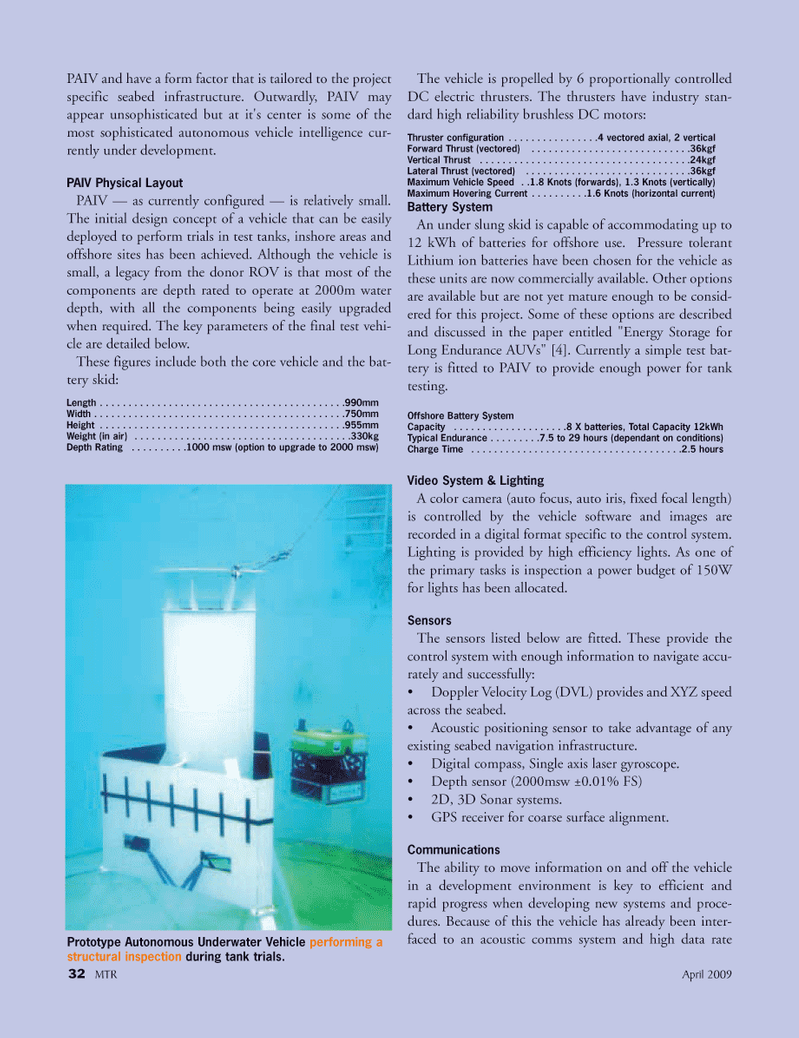
Page 32: of Marine Technology Magazine (April 2005)
Read this page in Pdf, Flash or Html5 edition of April 2005 Marine Technology Magazine
32 MTR April 2009
PAIV and have a form factor that is tailored to the project specific seabed infrastructure. Outwardly, PAIV may appear unsophisticated but at it's center is some of the most sophisticated autonomous vehicle intelligence cur- rently under development.
PAIV Physical Layout
PAIV — as currently configured — is relatively small.
The initial design concept of a vehicle that can be easily deployed to perform trials in test tanks, inshore areas and offshore sites has been achieved. Although the vehicle is small, a legacy from the donor ROV is that most of the components are depth rated to operate at 2000m water depth, with all the components being easily upgraded when required. The key parameters of the final test vehi- cle are detailed below.
These figures include both the core vehicle and the bat- tery skid:
Length . . . . . . . . . . . . . . . . . . . . . . . . . . . . . . . . . . . . . . . . . . .990mm
Width . . . . . . . . . . . . . . . . . . . . . . . . . . . . . . . . . . . . . . . . . . . .750mm
Height . . . . . . . . . . . . . . . . . . . . . . . . . . . . . . . . . . . . . . . . . . .955mm
Weight (in air) . . . . . . . . . . . . . . . . . . . . . . . . . . . . . . . . . . . . . .330kg
Depth Rating . . . . . . . . . .1000 msw (option to upgrade to 2000 msw)
The vehicle is propelled by 6 proportionally controlled
DC electric thrusters. The thrusters have industry stan- dard high reliability brushless DC motors:
Thruster configuration . . . . . . . . . . . . . . . .4 vectored axial, 2 vertical
Forward Thrust (vectored) . . . . . . . . . . . . . . . . . . . . . . . . . . . .36kgf
Vertical Thrust . . . . . . . . . . . . . . . . . . . . . . . . . . . . . . . . . . . . .24kgf
Lateral Thrust (vectored) . . . . . . . . . . . . . . . . . . . . . . . . . . . . .36kgf
Maximum Vehicle Speed . .1.8 Knots (forwards), 1.3 Knots (vertically)
Maximum Hovering Current . . . . . . . . . .1.6 Knots (horizontal current)
Battery System
An under slung skid is capable of accommodating up to 12 kWh of batteries for offshore use. Pressure tolerant
Lithium ion batteries have been chosen for the vehicle as these units are now commercially available. Other options are available but are not yet mature enough to be consid- ered for this project. Some of these options are described and discussed in the paper entitled "Energy Storage for
Long Endurance AUVs" [4]. Currently a simple test bat- tery is fitted to PAIV to provide enough power for tank testing.
Offshore Battery System
Capacity . . . . . . . . . . . . . . . . . . . .8 X batteries, Total Capacity 12kWh
Typical Endurance . . . . . . . . .7.5 to 29 hours (dependant on conditions)
Charge Time . . . . . . . . . . . . . . . . . . . . . . . . . . . . . . . . . . . . .2.5 hours
Video System & Lighting
A color camera (auto focus, auto iris, fixed focal length) is controlled by the vehicle software and images are recorded in a digital format specific to the control system.
Lighting is provided by high efficiency lights. As one of the primary tasks is inspection a power budget of 150W for lights has been allocated.
Sensors
The sensors listed below are fitted. These provide the control system with enough information to navigate accu- rately and successfully: Doppler Velocity Log (DVL) provides and XYZ speed across the seabed. Acoustic positioning sensor to take advantage of any existing seabed navigation infrastructure. Digital compass, Single axis laser gyroscope. Depth sensor (2000msw ±0.01% FS) 2D, 3D Sonar systems. GPS receiver for coarse surface alignment.
Communications
The ability to move information on and off the vehicle in a development environment is key to efficient and rapid progress when developing new systems and proce- dures. Because of this the vehicle has already been inter- faced to an acoustic comms system and high data rate
Prototype Autonomous Underwater Vehicle performing a structural inspection during tank trials.
MTR#3 (18-33).qxd 3/27/2009 2:23 PM Page 32

 31
31

 33
33
